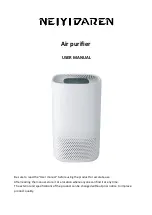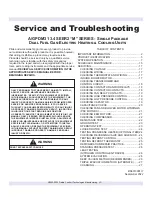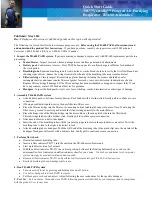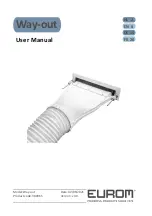
689670-BIM-A-0311
Johnson Controls Unitary Products
51
Troubleshooting
On calls for cooling, if the compressors are operating but the
supply air blower motor does not energize after a short delay
(the room thermostat fan switch is in the “AUTO” position).
1.
Turn the thermostat fan switch to the ON position. If the
supply air blower motor does not energize, go to Step 3.
2.
If the blower motor runs with the fan switch in the ON
position but will not run after the compressor has energized
when the fan switch is in the AUTO position, check the
room thermostat for contact between R and G in the AUTO
position during calls for cooling.
3.
If the supply air blower motor does not energize when the
fan switch is set to ON, check that line voltage is being
supplied to the contacts of the M3, contactor, and that the
contactor is pulled in. Check for loose wiring between the
contactor and the supply air blower motor.
4.
If M3 is pulled in and voltage is supplied to M3, lightly touch
the supply air blower motor housing. If it is hot, the motor
may be off on internal protection. Cancel any thermostat
calls and set the fan switch to AUTO. Wait for the internal
overload to reset. Test again when cool.
5.
If M3 is not pulled in, check for 24 volts at the M3 coil. If 24
volts are present at M3 but M3 is not pulled in, replace the
contactor.
6.
Failing the above, if there is line voltage supplied at M3, M3
is pulled in, and the supply air blower motor still does not
operate, replace the motor.
7.
If 24 volts is not present at M3, check that 24 volts is
present at the UCB supply air blower motor terminal,
“FAN”. If 24 volts is present at the FAN, check for loose
wiring between the UCB and M3.
8.
If 24 volts is not present at the “FAN” terminal, check for 24
volts from the room thermostat. If 24 volts are not present
from the room thermostat, check for the following:
a. Proper operation of the room thermostat (contact
between R and G with the fan switch in the ON position
and in the AUTO position during operation calls).
b. Proper wiring between the room thermostat and the
UCB.
c. Loose wiring from the room thermostat to the UCB.
9.
If 24 volts is present at the room thermostat but not at the
UCB, check for proper wiring between the thermostat and
the UCB, i.e. that the thermostat G terminal is connected to
the G terminal of the UCB, and for loose wiring.
10. If the thermostat and UCB are properly wired, replace the
UCB.
On a call for cooling, the supply air blower motor is operating
but the compressor is not (the room thermostat fan switch is in
the “AUTO” position).
1.
If installed, check the position of the economizer blades. If
the blades are open, the economizer is providing free
cooling and the compressors will not immediately operate.
If both stages of cooling are requested simultaneously and
the economizer provides free cooling, following a short
delay the compressor will be energized unless it is locked
out, unless this option has been disabled through computer
communications.
2.
If no economizer is installed or the economizer is not
opening to provide free cooling and the compressor does
not energize on a call for cooling, check for line voltage at
the compressor contactor, M1, and that the contactor is
pulled in. Check for loose wiring between the contactor and
the compressor.
3.
If M1 is pulled in and voltage is supplied at M1, lightly touch
the compressor housing. If it is hot, the compressor may be
off on inherent protection. Cancel any calls for cooling and
wait for the internal overload to reset. Test again when
cool.
4.
If M1 is not pulled in, check for 24 volts at the M1 coil. If 24
volts are present and M1 is not pulled in, replace the
contactor.
5.
Failing the above, if voltage is supplied at M1, M1 is pulled
in, and the compressor still does not operate, replace the
compressor.
6.
If 24 volts is not present at M1, check for 24 volts at the
UCB terminal, C1. If 24 volts is present, check for loose
wiring between C1 and the compressor contactor.
7.
If 24 volts is not present at the C1 terminal, check for 24
volts from the room thermostat at the UCB Y1 terminal. If
24 volts is not present from the room thermostat, check for
the following:
a. 24 volts at the thermostat Y1 terminal
b. Proper wiring between the room thermostat and the
UCB, i.e. Y1 to Y1, Y2 to Y2
c. Loose wiring from the room thermostat to the UCB.
Troubleshooting of components may require opening
the electrical control box with the power connected to
the unit.
Use extreme care when working with live
circuits!
Check the unit nameplate for the correct line
voltage and set the voltmeter to the correct range before
making any connections with line terminals.
When not necessary, shut off all electric power to the
unit prior to any of the following maintenance
procedures so as to prevent personal injury.
Label all wires prior to disconnection when servicing
controls. Wiring errors can cause improper and
dangerous operation which could cause injury to person
and/or damage unit components. Verify proper
operation after servicing.





































